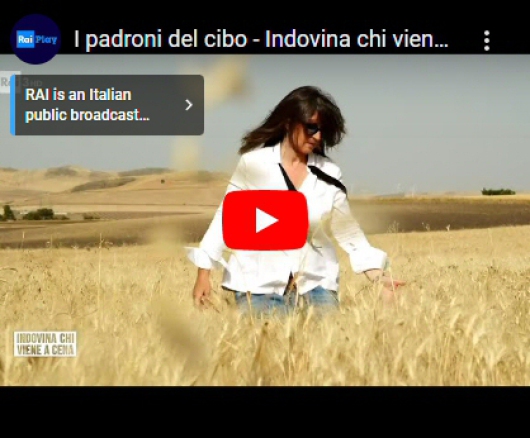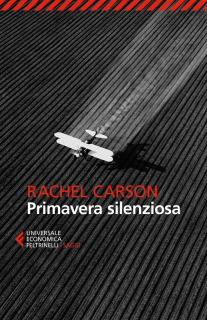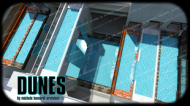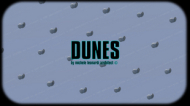time to lose 2
seconds and minutes of wasted time
DEFLYPHICATION
against
THE POWER
OF LOVE
or
Even flies want to live!
What good is a world without mosquitoes, weeds
and intelligent people?
"Deflyphication (Mammon) Vs. The Power of Love"
An animated Gif by Michele Leonardi © February 2019.
14 seconds of wasted time.
For the commercial use or any different use of my animations,
graphics, video and pictures, please contact me. M.L.
Rachel Carson
(1940)
BIBLIOGRAPHY
Rachel Louise Carson: "Silent spring" (first edition: 1962), Houghton Mifflin Harcourt, Boston, Massachusetts, U.S.A., Anniversary Edition, 2002; Introduction by Al Gore, 1994.
"A handsome anniversary edition of the classic environmental study discusses the reckless annihilation of fish and birds by the use of pesticides and warns of the possible genetic effects on humans, in a volume that incorporates new essays by Terry Tempest Williams and Linda Lear."
James Lovelock: "Gaia. A new look at life on Earth", Oxford University, U.K., 1979.
In this classic work that continues to inspire its many readers, James Lovelock deftly explains his idea that life on earth functions as a single organism. Written for the non-scientist, Gaia is a journey through time and space in search of evidence with which to support a new and radically different model of our planet. In contrast to conventional belief that living matter is passive in the face of threats to its existence, the book explores the hypothesis that the earth's living matter-air, ocean, and land surfaces-forms a complex system that has the capacity to keep the Earth a fit place for life. Since Gaia was first published, many of Jim Lovelock's predictions have come true, and his theory has become a hotly argued topic in scientific circles. Here, in a new Preface, Lovelock outlines his present state of the debate.
G. E. Griffin, M. J. Murphy, P. Wittenberger: "What in the World are They Spraying?", Documentary, 2011.
Interventions or quotes by: David Keith, geoengineer. - Dane Wigington, solar expert. - Alan Robock, geoengineer. - Michael J. Murphy, journalist. - Ken Caldeira, geoengineer. - M. Granger Morgan, Departement of Engineering and Public Policy, Carnegie Mellon University. - G. Edward Griffin, author. - Mauro Oliveira, geoengineeringwatch.org . - Francis Mangels, USDA (United States Department of Agriculture) biologist. - Karen Johnson, former Arizona State senator. - Jeanne Angelhearth, former mayor, Evergun, Belgium. - Desiree Rover, medical research journalist. - Jeremy Rothe-Kushel, activist.
Michael J. Murphy: "Why in the World are They Spraying?", Documentary, 2012.
Interventions or quotes by: David Keith, geoengineer. - Ken Caldeira, geoengineer. - Michael J. Murphy, filmmaker. - Francis Mangels, USDA biologist, 35 years in USDA Soil Conservation Service. - Barb Peterson, small farmer/rancher. - Rosalind Peterson, retired USDA Farm Service Agency Agriculture Crop Loss Adjuster, President of the Agriculture Defence Coalition. - Mark McCandlish, Defence and Aerospace Industry conceptual artist and designer. - Scott Stevens, former television weatherman 1983-2005. - Dane Wigington, solar expert. - Dr.James Fleming, Professor of Science, Technology and Society, Colby College. - Michael Agne, indipendent commodities trader at the Chicago Mercantile Exchange. - Larry Oxley, investor, author of "Extreme Weather and Financial Markets". - Sherrie Klappert, certified organic farmer, Hawaii. - Joel Gilcoca, certified organic farmer, Hawaii.
Antonietta M. Gatti and Stefano Montanari: "Nanopathology: The health impact of nanoparticles", Pan Stanford Publishing, Singapore, Singapore, 2008.
Enormous funds are currently being invested in nanotechnology, yet very little is known about how its products and by-products can interfere with both end users and people involved in their manufacture. Similar scenarios are already widely known in the history of science, such as the exploitation of radioactivity or the controversial issue of genetically modified organisms. As nanoparticles are more or less voluntarily produced, they are almost uncontrollably disseminated in the environment and in organisms and thus constitute a growing concern. By describing the impact of nanoparticles (and microparticles) on human and animal health, this book offers the first criteria for preventing potential problems deriving from these particles.
Antonietta M. Gatti and Stefano Montanari: "Case studies in nanotoxicology and particle toxicology", Academic Press, Cambridge, Massachusetts, U.S.A., 2015.
Case Studies in Nanotoxicology and Particle Toxicology presents a highly-illustrated analysis of the most prominent cases on the adverse effects of nanoparticles and their impact on humans and the environment.
This comprehensive reference demonstrates the possible risks imposed by managing and handling nanoparticles, showing the effects of involuntary inhalation or ingestion during their use and after their incineration.
Through the use of numerous examples, readers will discover the possible risks and effects of working with nanoparticles, along with best practices to prevent these effects. The text is an essential reference for anyone working in the risk assessment of nanoparticles, including nanosafety professionals, occupational toxicologists, regulatory toxicologists, and clinicians.
Presents real-life cases showing the potential risks to human health following exposure to nanoparticles.
An ideal reference for anyone working in the risk assessment of nanoparticles, including nanosafety professionals, occupational toxicologists, regulatory toxicologists, and clinicians.
Provides examples to help assess risks of handling engineered nanomaterials.
Advises on the best forms of protection and the safest nanotechnological products.
Holly Jean Buck: "After Geoengineering: Climate Tragedy, Repair, and Restoration", Verso, 2019.
What if the people seized the means of climate production?
The window for action on climate change is closing rapidly. We are hurtling ever faster towards climate catastrophe—the destruction of a habitable world for many species, perhaps the near-extinction of our own. As anxieties about global temperatures soar, demands for urgent action grow louder. What can be done? Can this process be reversed? Once temperatures rise, is there any going back? Some are thinking about releasing aerosols into the stratosphere in order to reflect sunlight back into space and cool the earth. And this may be necessary, if it actually works. But it would only be the beginning; it’s what comes after that counts.
In this groundbreaking book, Holly Jean Buck charts a possible course to a liveable future. Climate restoration will require not just innovative technologies to remove carbon from the atmosphere, but social and economic transformation. The steps we must take are enormous, and they must be taken soon. Looking at industrial-scale seaweed farms, the grinding of rocks to sequester carbon at the bottom of the sea, the restoration of wetlands, and reforestation, Buck examines possible methods for such transformations and meets the people developing them.
Both critical and utopian, speculative and realistic, After Geoengineering presents a series of possible futures. Rejecting the idea that technological solutions are some kind of easy workaround, Holly Jean Buck outlines the kind of social transformation that will be necessary to repair our relationship to the earth if we are to continue living here.
"WeatherWar101": No Natural Weather: Introduction to Geoengineering 101, Foreword by Sofia Smallstorm, Independently Published, 2017.
Excerpt form Foreword: "Once upon a time, all over the world, we saw fluffy white clouds in a blue sky. Today we see white lines and streaks, and many of us, in many countries, live under a layer of white haze. Children no longer know what real clouds look like, as the three basic cloud types are no longer seen. Remember the high-altitude cirrus, feathery and white, made of ice crystals? I have not seen real cirrus clouds for 15 years. What occurs now is what NASA calls “man-made cirrus” or “jet cirrus” – an actual admission of something unnatural and artificial. “No Natural Weather” is a clearly written simple tutorial about weather modification and much more, designed for newcomers to the concept, but also full of explanations and clarifications that will add to the research of those who are already aware. Start at the beginning and let this narrative take you on a journey from soup to nuts, A to Z. Share the series with your family and friends! There is no better time than now to educate yourself to what is and has been going on, and the thoughtful guidance provided by this seasoned researcher is the best company you could have on such an alarming journey. For yes, it is alarming to learn that our planet is being altered in ways that it may never recover from. It is time for us all to voice our collective power, but no one can do so until the actual knowledge has been given and shared. Thank you, WeatherWar101, for your immense contribution! Sofia Smallstorm."
( MORE BIBLIOGRAPHY )
The different vision by Geoengineering :
David Keith: "A Case for Climate Engineering", MIT Press, Massachusetts Institute of Technology, MA, USA, Boston Review Books, 2013.
A leading scientist argues that we must consider deploying climate engineering technology to slow the pace of global warming.
Climate engineering - which could slow the pace of global warming by injecting reflective particles into the upper atmosphere - has emerged in recent years as an extremely controversial technology. And for good reason: it carries unknown risks and it may undermine commitments to conserving energy. Some critics also view it as an immoral human breach of the natural world. The latter objection, David Keith argues in A Scientist's Case for Climate Engineering, is groundless; we have been using technology to alter our environment for years. But he agrees that there are large issues at stake.
A leading scientist long concerned about climate change, Keith offers no naïve proposal for an easy fix to what is perhaps the most challenging question of our time; climate engineering is no silver bullet. But he argues that after decades during which very little progress has been made in reducing carbon emissions we must put this technology on the table and consider it responsibly. That doesn't mean we will deploy it, and it doesn't mean that we can abandon efforts to reduce greenhouse gas emissions. But we must understand fully what research needs to be done and how the technology might be designed and used. This book provides a clear and accessible overview of what the costs and risks might be, and how climate engineering might fit into a larger program for managing climate change.
DISCLAIMER:
The chemistry is not evil and "bio" is not the nirvana of ecology.
Systemic Habitats is a personal non-profit website with cultural purposes only. No doctrine, no any pearl of wisdom, no any final truth is propagated here. This site does not represent a mass media as it is not updated periodically, nor is it to be considered as an information medium or an editorial product, nor as a kind of discussion forum. Although this is a priori obvious, the cultural contents mentioned or referred here, in the form of videos or books, do not automatically reflect in whole or in part the opinions of the undersigned editor. Criticizing certain realities of contemporary culture and civilization does not mean demonizing everything and everyone, nor does it mean throwing the baby out with the bathwater. We are not interested in extremism and prejudice. All texts should be read not "with a magnifying glass" but with one's own eyes. Who has never sensibly managed a garden, or a vegetable garden, or even an apartment balcony with plants or even just a pot with a plant placed on a window sill, or anything organic in his or her life? Or at least himself?!!
M.L.
Insostenibile agricoltura
I padroni del cibo:
indovina chi viene a cena
Gli insetti stanno scomparendo
Report sul glifosato
Come evitare l'estinzione delle api?
BIBLIOGRAFIA
Rachel Louise Carson: "Primavera silenziosa", con introduzione di Al Gore, Feltrinelli Editore, Milano, 1966-1994-2016-2020.
Dalla recensione di quarta di copertina del libro: "È raro che un libro riesca a modificare il corso della storia, eppure questo saggio è riuscito a farlo. "Il libro di Rachel Carson, pietra miliare dell'ambientalismo, è la prova innegabile di quanto il potere di un'idea possa essere di gran lunga più forte del potere dei politici": così, nella sua introduzione, Al Gore, vicepresidente degli Stati Uniti nell'amministrazione Clinton. Carson previde con forte anticipo sui suoi tempi gli effetti in agricoltura dell'uso degli insetticidi chimici, e di sostanze velenose, inquinanti, cancerogene o letali, sull'uomo e sulla natura. Dopo la pubblicazione dell'opera nel 1962, il DDT è stato vietato e si è presa una serie di provvedimenti legislativi in materia di tutela ambientale. L'appassionato impegno, lo scrupoloso rispetto della verità e il coraggio personale della sua autrice sono serviti da modello nella lotta per la difesa dell'ambiente in tutto il mondo, e lei stessa può essere considerata "madre" del movimento ambientalista. Primavera silenziosa, che è ormai un classico e conserva tuttora una grandissima attualità, dimostra che esistono diverse alternative all'irresponsabile e impudente avvelenamento del pianeta da parte delle industrie chimiche. Per evitare che la primavera scompaia dalla faccia della Terra".
Elisabetta Intini: "Ambiente. I neonicotinoidi nel miele di tutto il mondo", Focus, 2020.
I pesticidi che minacciano le api si trovano in tre quarti di tutti i campioni dell'alimento, e in ogni continente o isola remota. L'entità del danno per gli impollinatori è ormai globale.
Elisabetta Intini: "Ambiente. Il tuo supermercato, se sparissero le api", Focus, 2020.
Lo spopolamento degli alveari, l'ecatombe degli impollinatori... Quali ricadute avrebbe la scomparsa di questi animali sulla nostra alimentazione?
James Lovelock: "Gaia", Bollati Boringheri, Torino, 2011.
L'idea che ha rivoluzionato l'ecologia. La Terra come un unico organismo vivente capace di autoregolarsi.
Quando è apparso per la prima volta (1979) questo libro ha rivoluzionato l'ecologia e gli studi sull'ambiente offrendo finalmente una prospettiva nuova, equidistante dalle ottiche catastrofiste e da quelle improntate a eccessivo ottimismo. Secondo Lovelock la Terra è Gaia, un unico organismo vivente capace di autoregolarsi e di rispondere a tutti quei fattori nuovi e avversi che ne turbano gli equilibri naturali. La materia vivente non rimane passiva di fronte a ciò che minaccia la sua esistenza: gli oceani, l'atmosfera, la crosta terrestre e tutte le altre componenti geofisiche del pianeta si mantengono in condizioni idonee alla presenza della vita proprio grazie al comportamento e all'azione degli organismi viventi, vegetali e animali. Lovelock offre così un'alternativa alle concezioni di chi vede la natura come una forza primitiva da sottomettere o conquistare; o di chi considera la Terra come una nave spaziale impazzita, che ruota senza meta nel cosmo.
Rosalie Bertell: "Pianeta Terra. L'ultima arma di guerra", e a cura di Maria Heibel, Asterios Editore, Trieste, 2018.
Questo libro nutre una radicale speranza di affrontare la nostra difficile situazione. È vero, la sua proposta di eliminare tutti gli eserciti e tutti gli irresponsabili esperimenti degli apparati militari e dei loro partner corporativi sembra un obiettivo impossibile nelle attuali condizioni del mondo, ben oltre le nostre capacità ed iniziative. Rosalie Bertell però ha indicato le cose giuste da fare. Il nostro comportamento quotidiano alimenta il sistema patriarcale alla radice del regime dominante, che sta ora raggiungendo livelli di violenza e irrazionalità senza precedenti. I nostri modelli di consumo e i nostri atteggiamenti politici subordinati - il fascista che tutti portiamo dentro di noi, come dice Foucault - sono le fondamenta ultime della situazione attuale. È nostra responsabilità rompere questo circolo vizioso, riformando cuori e menti per adottare altri comportamenti. Abbiamo bisogno di aprirci a nuovi atteggiamenti, come suggerito da Bertell, incorporando totalmente una attitudine postpatriarcale, come descritto in questo libro, rinunciando radicalmente al sistema gerarchico a noi imposto. Abbiamo bisogno di smantellare pacificamente il sistema dominante, a partire dal basso, un percorso sicuro per la trasformazione necessaria.
Prefazioni di Manlio Dinucci, Gustavo Esteva, Claudia von Werlhof.
Stefano Montanari: "Il pianeta impolverato. Polveri sottili che innescano le malattie", Arianna Editrice-Macrolibrarsi, Diegaro di Cesena, 2014.
Per affrontare con successo i problemi occorrono almeno tre cose: sapere che esistono, essere capaci di risolverli, volerli risolvere. Che di problemi il mondo ne abbia molti è un fatto noto, ma probabilmente poche sono le persone che si rendono conto di come quello dell'avvelenamento del pianeta sia in assoluto il più grave. "Il Pianeta Impolverato" descrive in modo diretto il cammino compiuto per arrivare alla situazione attuale dell'ambiente e la fotografa senza ipocrisie.
Stefano Montanari: "L'insidia delle polveri sottili e delle nanoparticelle. Se le conosci le eviti", libro e video DVD, Macrovideo, Roma.
L'inquinamento da polveri inorganiche costituisce un'insidia formidabile per la nostra salute: non sono biodegradabili, non sono biocompatibili e l'ultimo aggettivo è sinonimo di patogeno. Che cosa sono le polveri sottili? Come si formano? Qual è il reale "contributo" della Natura nella produzione di particolato inorganico ultrafine? Montanari esamina le gravi responsabilità dell'Uomo su questa fonte d'inquinamento che sta pesantemente e rapidamente cambiando le condizioni ambientali del Pianeta e ha anche effetti genotossici sugli embrioni umani. Come possiamo difenderci da questo pericolo?
Eugenio Benetazzo: "Scie chimiche e signoraggio", in Italian, Libro e DVD, Macrovideo, 2009.
Dalle scie chimiche al signoraggio l'autore affronta, anche con momenti di comicità, quanto sta accadendo silenziosamente nei nostri cieli e quanto si sta facendo per nascondere la vera origine del debito pubblico italiano.
Marco Pizzuti: "Emergenze climatiche non autorizzate. Ciò che i media non dicono”, 352 pgg., Ed. Il Punto d’Incontro, 2024.
Prove inconfutabili che gli eventi climatici estremi sono compatibili con gli effetti della geoingegneria e delle armi ad energia diretta.
Dal 2001 in poi, il mondo intero è stato scosso da continue emergenze: terrorismo, crack finanziari, immigrazione, pandemie, costo e reperibilità delle materie prime, iperinflazione, conflitti Ucraina-Russia e Israele-Hamas e, non da ultima, l’apocalisse climatica. Marco Pizzuti smonta il teorema imposto dal pensiero unico, svela le trame dietro la presunta emergenza climatica e offre le prove del piano messo in atto per sottomettere gli Stati all’agenda green imposta dal World Economic Forum di Klaus Schwab.
L'autore ha raccolto le prove per dimostrare che gran parte degli eventi climatici più estremi degli ultimi anni è compatibile con gli effetti prodotti da geoingegneria e armi a energia diretta, che lasciano una traccia indelebile del loro utilizzo. Senza tralasciare che dalla fine degli anni ’90 in poi, il controverso progetto dell’aviazione USA per il controllo del clima ha modificato l’aspetto dei cieli dei Paesi N.A.T.O., nei quali sono apparse “anomale scie di condensa” rilasciate da velivoli con rotte a scacchiera. Ogni anno i membri del World Economic Forum si riuniscono per stabilire gli obiettivi da raggiungere e il tipo di società globale in cui dovremo vivere. Uno dei loro cavalli di battaglia è proprio l’emergenza climatica che, stando alla denuncia di più di mille autorevoli scienziati di tutto il mondo, in realtà fa parte dei normali cicli climatici e non dipende dalle emissioni di CO2. Le prime cento aziende del mondo sono responsabili di più del 70% dell’inquinamento globale, ma per i proprietari di queste corporation, che si riuniscono ogni anno a Davos con i loro 1500 jet privati, la colpa dell’apocalisse climatica da surriscaldamento sarebbe da imputare ai comuni cittadini, perché utilizzano auto a combustione e non hanno abitazioni in classe energetica soddisfacente. L’emergenza climatica ha tutte le caratteristiche di un espediente usato dalla super élite di Davos per instaurare una sua governance globale con il consenso delle masse, impaurite ad arte.
(ULTERIORE BIBLIOGRAFIA)
La diversa visione delle cose, quella della Geoingegneria, che con i suoi pro e con i suoi contro si può già far rientrare nella più vasta disciplina della "terraformazione" (terraforming):
David Keith: "L'alternativa razionale. I pro e i contro dell'ingegneria climatica", Bollati Boringhieri, Torino, 2015.
Decenni di discussioni sul riscaldamento globale hanno finora portato solo a politiche confuse, fatte più di roboanti dichiarazioni che di soluzioni reali. Intanto il carbonio nell'atmosfera continua a crescere e l'effetto serra si intensifica. Davvero non si può fare nient'altro? In effetti sì, tecnicamente si può, e costerebbe anche molto poco. Ma la soluzione proposta si scontra con una comprensibile resistenza da parte di molti. Una delle proposte (mai comunque in opposizione alla riduzione delle emissioni di CO2, che resta un obiettivo necessario) si chiama "geoingegneria", un insieme di tecnologie volte a modificare artificialmente il clima della Terra. La tecnica si basa sul rilascio nella stratosfera di gocce di acido solforico, che agirebbero come un ombrello contro i raggi del Sole. Non parlare di questi temi potrebbe costarci caro. Parlarne in maniera poco informata, anche di più. Per questo uno dei principali esperti mondiali di tecnologie climatiche ha voluto scrivere questo libro: per discutere in base alle conoscenze e valutare se all'umanità convenga iniziare seriamente a investire nel settore dell'ingegneria ambientale.














































